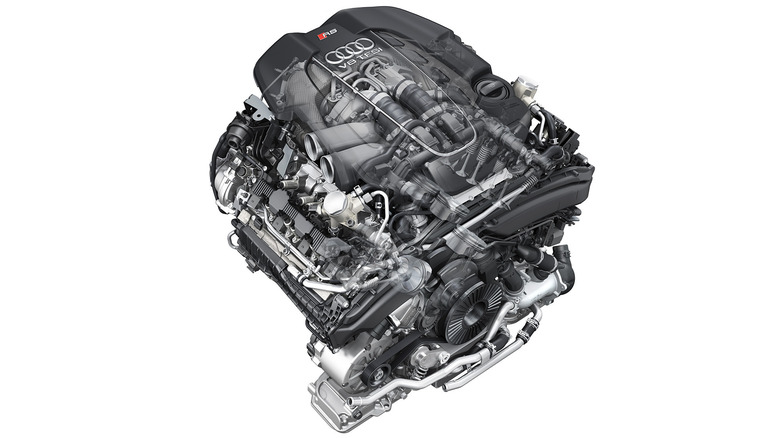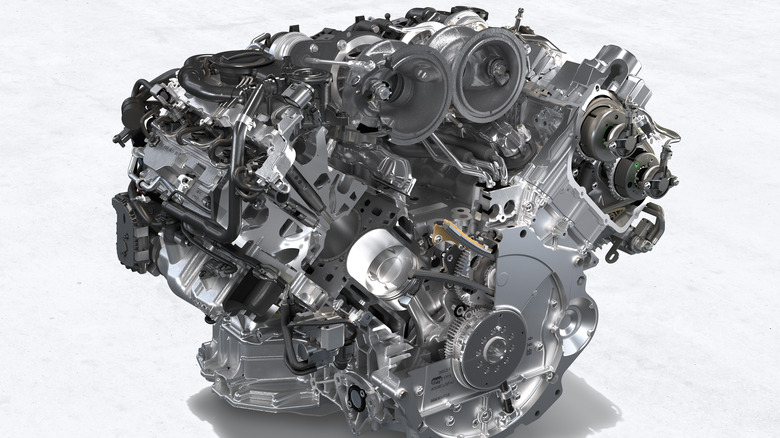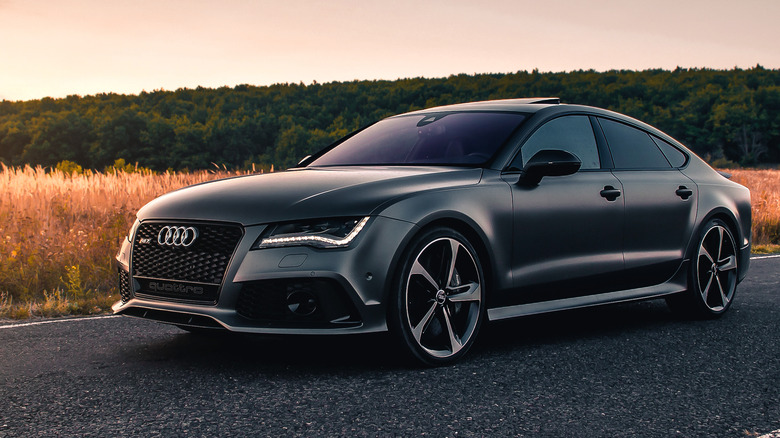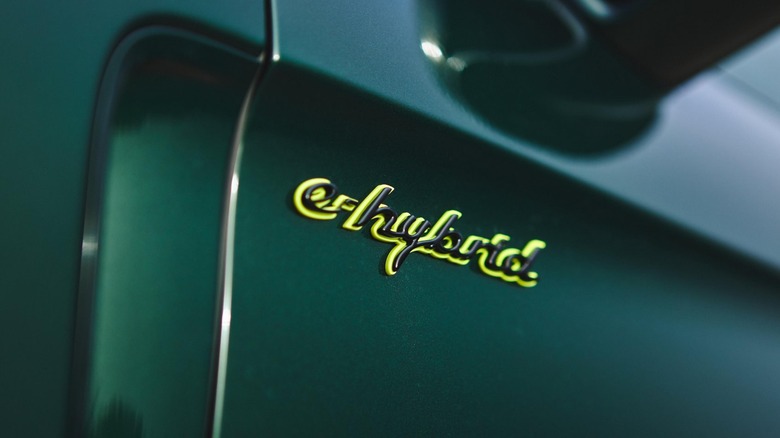A Look At The 4.0 TFSI Engine That Powers The Audi RS 7 Sportback
The Audi RS7 Sportback is one of the most dramatic-looking big fastbacks ever made, and what powers it is equally special. Hiding under the RS7's long hood is a 4-liter twin-turbo V8 engine, found in some Porsche, Bentley, and Lamborghini models. Its ample torque and power turn the RS7 into a straight-line monster with supercar-rivaling acceleration and an impressive top speed.
The first version of this engine debuted in 2012 when it was made available in the S6, S7 Sportback, and S8, and it already had all of the characteristics that we see in the latest iteration of the power plant. The S6 and S7 made 414 horsepower and 405 lb-ft of torque, while the larger S8 was pushed to 513 horsepower and 479 lb-ft.
Audi was a few years behind its competitors in introducing its downsized twin-turbo V8 — it was the last of Germany's big trio of luxury manufacturers to offer one. BMW launched its S63 hot vee V8 in 2008, and Mercedes-Benz revealed its 5.5-liter twin-turbo in 2010. Because Audi launched its engine last, it had time to study its competitors, and this helped it produce a remarkably punchy unit that matched its rivals' offerings.
The modern version of the Audi twin-turbo V8 makes up to 621 horsepower in Performance versions of Audi's large RS models, allowing vehicles like the RS7 to accelerate from 0 to 60 mph in 3.3 seconds. It makes even more power under the hood of the Lamborghini Urus Performante, and it allows the bigger, heavier SUV to have the same benchmark sprint time as the Audi RS7 Performance.
The geeky, technical stuff
The Audi twin-turbo V8 has an exact displacement of 3,996 cc and a fairly typical 90-degree vee angle between its two banks of four cylinders. The block is made out of an aluminum-silicon alloy with a high portion of silicon through a special process of low-pressure chill casting, which minimizes the chances of microcracks or any other imperfections appearing. The alloy used also makes the insides of the cylinders very resistant to wear, which means the automaker went to great lengths to make sure these blocks were dependable and long-lasting.
The cylinder linings get a very thin iron coating, further improving their heat dissipation properties and their resistance to wear.
What gives this engine its renowned responsiveness is the fact that the two turbochargers are placed inside the vee of the engine. This means the air they force into the cylinders has a shorter distance to travel before it reaches the combustion chamber. You experience this from behind the wheel as a very eager response from the engine to every press of the gas pedal.
The engine features direct fuel injection and variable valve timing, which improve performance and efficiency and further boost responsiveness. In its latest iteration, it's also available as a mild hybrid, and it comes with cylinder deactivation to help save fuel. The addition of the mild hybrid's integrated starter generator makes the stop-start system considerably smoother, allowing the vehicle to cut the engine at speeds up to 13.7 mph.
Models and power outputs
Audi puts the high-power version of its twin-turbo V8 in the RS6, RS7, RS Q7, and RS Q8. In all these vehicles, the engine is offered in its standard state of tune with 591 horsepower and 590 lb-ft of torque, but you can pay extra to increase the figures to 621 horsepower and 627 lb-ft of torque. The extra oomph is achieved through larger turbochargers and an increase in boost pressure from 2.4 to 2.6 bar.
You can also get this engine in a lower state of tune in non-RS Audi models, like the SQ7, SQ8, and S8, making 500 horsepower in the two SUVs and 563 horsepower in the flagship sedan.
Porsche also uses a version of the Audi V8 in its Panamera and Cayenne models. The Cayenne S makes 468 horsepower, while in the pre-2023 Cayenne Turbo GT, it was pushed to 631 horsepower. Aside from the Cayenne S, you can't get this engine in a non-plug-in Porsche today.
The engine is versatile enough for cars from Volkswagen's ultra-luxurious Bentley brand, powering the base versions of models like the Continental and Bentayga. In both of these applications, the 4-liter V8 makes 542 horsepower and 568 lb-ft of torque, and it pushes the Continental coupe to sixty in under 4 seconds and on to almost 200 mph.
Lamborghini uses a different version of the same engine to power its Urus super SUV. The base trim makes 641 horsepower and 626 lb-ft of torque, and the Performante pushes the power to 657 horsepower. When Car and Driver tested the Urus Performante, it was quicker than claimed, sprinting to sixty in 3.1 seconds.
Plug-in hybrids
The Audi V8 was used to power top versions of Porsche's larger models, the Cayenne and Panamera, but with the latest facelift, the manufacturer has removed these variants. The range-topping models from either lineup are now plug-in hybrids, which use powerful electric motors to produce remarkably high combined outputs. The Cayenne Turbo E-Hybrid has the 591 horsepower version of the engine, but it also has a 174 horsepower electric motor, and together, they can produce a peak of 729 horsepower combined, good for 0 to 60 mph in 3.5 seconds.
Lamborghini is also working on a plug-in hybrid version of the Urus, which will go on sale sometime in 2024. If history is any indication, it will become the most powerful application of this engine in a road car. It is expected to have around 800 horsepower, so it's going to be considerably more extreme than the Cayenne Turbo E-Hybrid, with enough power to surpass some of the world's most powerful SUVs, including the 750-horsepower BMW XM Label Red, which is also powered by a twin-turbo V8 plug-in hybrid.



